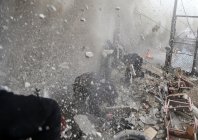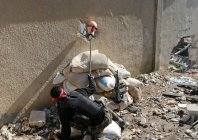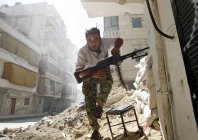
Combat
Goran Tomasevic
Reuters
Stalingrad, Beirut, Sarajevo… Damascus. The conflict in Syria has become a snipers’ war. In the capital and in Aleppo, men stalk their fellow man down telescopic sights along city streets or through velvet-curtained windows, hunting a glimpse of flesh, an eyeball peering from a crack; killing, and being killed.
Into the cat and mouse among the ruins, intrude the heavier threats of a tank or jet bomber. And now and then, the stalkers stumble into one another in the labyrinth, lashing out in panic with machineguns and grenades in the confines of a sitting room.
Goran Tomasevic, veteran Reuters war photographer, lived on the frontline during the summer 2012 battle for Aleppo and in the thick of the fighting in Damascus during winter 2013. His work provided daily evidence of an escalating conflict that has forced millions from their homes and killed an estimated 100 000 people.
Tomasevic photographed with exceptional proximity as combatants mounted complex attacks, managed logistics, treated their wounded, buried their dead - and died before his eyes.
“I wanted to be as close as I could to the fighters, to the very frontline, to show exactly what they are doing, their emotions, how they run and fire weapons, and also how they react to incoming shells,” says Tomasevic. “If you want to tell the true story you have to be there.”
Preview






At 44, he has witnessed conflicts in his native Yugoslavia, in Iraq, Afghanistan, between Israelis and Palestinians, in Libya and elsewhere: "I have been covering war for 20 years now, but I don’t see much change, especially with urban conflict like in Aleppo and Damascus. It reminds me of the Balkans, of the former Yugoslavia and of combat in World War II. I would have loved to have covered the Battle of Stalingrad."
What his pictures bring home is not just the bravery, but also the discipline and tactical capabilities of the rebel Free Syrian Army, as well as the fearlessness, order and superior weaponry of President Bashar al-Assad's regular troops. Their heavier firepower thwarted the rebel push in Aleppo, Syria's biggest city, and in Damascus it is holding the rebels out of the center, despite al-Assad losing swaths of suburbs.
Tomasevic's images tell of battles big and small. A tank shell slams home above him; bullets and shrapnel fill a room; anger, or fear stare into his lens; it also captures surprise and pain in men who are hit, sadness and prayer as they die.
“When I start covering a combat operation, for me mentally, there is no going back. I would be ashamed of myself not to follow it to the end. If you’re covering a story like Syria, you have to capture the most difficult moments. I cannot give up and betray the people in my images who are experiencing something much more difficult than I am.
Inspired by the street protests in the Arab Spring of 2011, bands of army deserters, Islamist radicals and men plucked from civilian life, wage an increasingly bitter, sectarian war against al-Assad and an elite dominated by his Alawite minority. With world powers hamstrung by rivalries and neighbors being drawn in, peace seems no closer and the war grinds on.
Alastair Macdonald, Former Reuters Bureau Chief, Jerusalem and Baghdad






